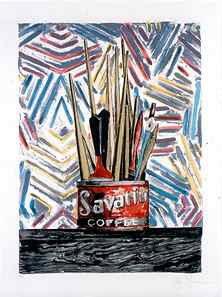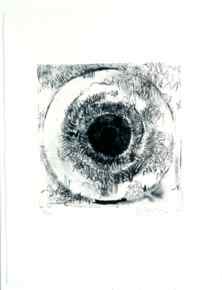Editor's note: The University of Arizona Museum
of Art provided source material to Resource Library Magazine for
the following article or essay. If you have questions or comments regarding
the source material, please contact the University of Arizona Museum of
Art directly through either this phone number or web address:
Jasper Johns: Prints from
the John and Maxine Belger Family Foundation
February 14 - March 28, 2004
Jasper Johns (born
1930) expanded our understanding of contemporary fine art printmaking. This
collection of works, produced between 1960 and the present, explores this
seminal artist's commitment toward his earliest Dadaist ideas as well as
an anxious but clearly present humanism. The exhibition  gathers together 60 prints from the Belger's collection
of over 100 in a variety of print media, including intaglio, lithography
and cast lead. The prints demonstrate not just John's vision but also the
working relationships he developed with printers who collaborated with him
in producing one of the most significant bodies of fine art prints in the
last century. The exhibition at the University of Arizona Museum of Art
was curated from the Belger Collection by Peter S. Briggs and will be on
exhibit from February 14 through March 28, 2004. (right: Savarin,
Universal Limited Art Editions,1977, lithograph: 17 aluminum plates, Twinrocker
paper; ULAE, 45 1/2 x 34 1/2 inches, Bill Goldston, James V. Smith, Ed.
25/50)
gathers together 60 prints from the Belger's collection
of over 100 in a variety of print media, including intaglio, lithography
and cast lead. The prints demonstrate not just John's vision but also the
working relationships he developed with printers who collaborated with him
in producing one of the most significant bodies of fine art prints in the
last century. The exhibition at the University of Arizona Museum of Art
was curated from the Belger Collection by Peter S. Briggs and will be on
exhibit from February 14 through March 28, 2004. (right: Savarin,
Universal Limited Art Editions,1977, lithograph: 17 aluminum plates, Twinrocker
paper; ULAE, 45 1/2 x 34 1/2 inches, Bill Goldston, James V. Smith, Ed.
25/50)
John's pushes beyond the technical assumptions printmaking
methods. He has exploited the use of commercial printing techniques such
as offset lithography and has replaced the sheet of paper with sheets of
lead that were then run through the press. These latter works undermine
our expectations of the often-delicate relationship of print with paper
and produce, instead, a work of dull gray metal with literal and metaphorical
weight.
Among the highlights in the exhibition are lithographs
done by Johns in the 1960s with the recently deceased master printmaker
Robert Blackburn. These include, for example Target (1960), 0
through 9 (1960), and Painting with Two Balls I (1962). In addition
the exhibition includes, 1st Etchings (1969), a suite of 13 intaglio
prints produced by ULAE; Decoy (1971, lithograph with die cuts);
The Dutch Wives (1978, silkscreen); Voices 2, a triptych (1982,
lithographs), After Holbien (1994, lithograph), and Green Angel
2 (1997, intaglio).
Technical accomplishments in printmaking during the last
half of the 20th century have made possible the production of fine art prints
of exceptional quality with a seemingly limitless inventory of technique.
Such advancements are the result, in large measure, of several pioneers
who were able to combine artist, master printmaker and publisher into dynamic
and unified creative endeavors. Tatyana Grosman, founder of ULAE, is one
of the most important of these pioneers in printmaking and in the development
of John's prints.
This exhibition explores in depth what has captivated many
in John's prints: his genius in the use of line, and the characteristic
elegance and resonance of his forms, from the most simple to the most complex.
His exploration of shades of grays compels us to examine with him the visual
and tactile qualities that can be extracted from one color. John's journey
continues. And we are fortunate that through this exhibition we can catch
a glimpse of his creative genius. (right: Target, Universal
Limited Art Editions, 1960, lithograph: 1 stone, Japan paper, 22 1/2 x 17
1/2 inches, Robert Blackburn, Ed. 5/30, Collection of Belger Arts Center
for Creative Studies. ©Belger Arts Center for Creative Studies)
The Belger Family Foundation, located in Kansas City, Missouri,
has a unique mission in the art world. Their collection, focused on a few
specific artists seeks to explore the creative process through the personal
and artistic journey. Rather than focusing on selected masterpieces, the
collection focuses on a large body of work by an individual artist. In addition
to Jasper Johns, the Belger Family Foundation collects work by William Christenberry,
Terry Winters, William Wiley, Jaune Quick-to-See Smith, Renee Stout, Robert
Stackhouse and Terry Allen. In the Foundation's quest to explore the creative
act, they created the Belger Arts Center for Creative Studies, also located
in Kansas City.
Editor's note: RLM readers may also enjoy these
earlier articles:
Read more articles and essays concerning this institutional
source by visiting the sub-index page for the University
of Arizona Museum of Art in Resource
Library Magazine.
Search for more
articles and essays on American art in Resource Library. See America's Distinguished Artists for biographical information on historic artists.
This page was originally published in 2004 in Resource
Library Magazine. Please see Resource Library's Overview section for
more information.
Copyright 2012 Traditional
Fine Arts Organization, Inc., an Arizona nonprofit
corporation. All rights reserved.
 gathers together 60 prints from the Belger's collection
of over 100 in a variety of print media, including intaglio, lithography
and cast lead. The prints demonstrate not just John's vision but also the
working relationships he developed with printers who collaborated with him
in producing one of the most significant bodies of fine art prints in the
last century. The exhibition at the University of Arizona Museum of Art
was curated from the Belger Collection by Peter S. Briggs and will be on
exhibit from February 14 through March 28, 2004. (right: Savarin,
Universal Limited Art Editions,1977, lithograph: 17 aluminum plates, Twinrocker
paper; ULAE, 45 1/2 x 34 1/2 inches, Bill Goldston, James V. Smith, Ed.
25/50)
gathers together 60 prints from the Belger's collection
of over 100 in a variety of print media, including intaglio, lithography
and cast lead. The prints demonstrate not just John's vision but also the
working relationships he developed with printers who collaborated with him
in producing one of the most significant bodies of fine art prints in the
last century. The exhibition at the University of Arizona Museum of Art
was curated from the Belger Collection by Peter S. Briggs and will be on
exhibit from February 14 through March 28, 2004. (right: Savarin,
Universal Limited Art Editions,1977, lithograph: 17 aluminum plates, Twinrocker
paper; ULAE, 45 1/2 x 34 1/2 inches, Bill Goldston, James V. Smith, Ed.
25/50)